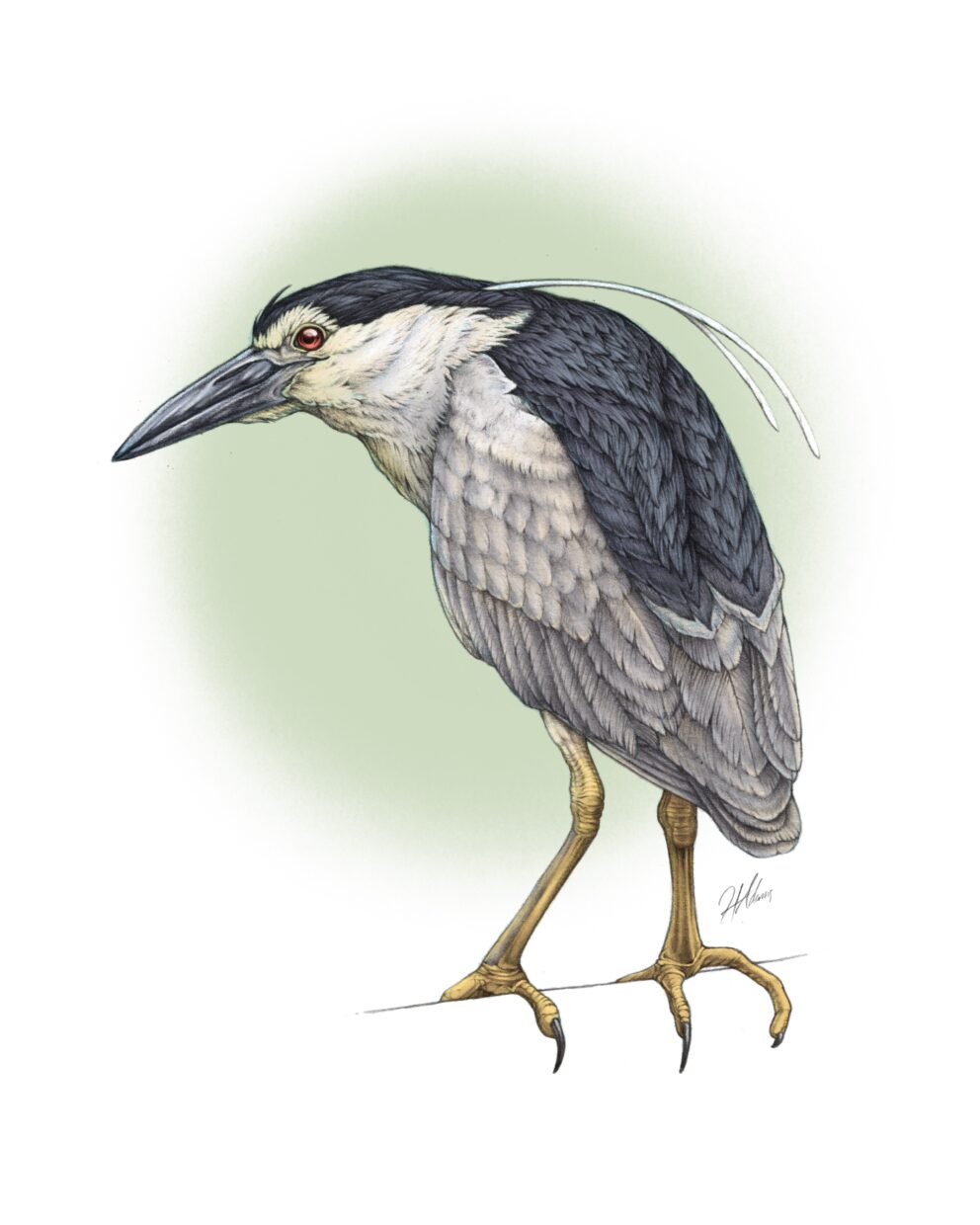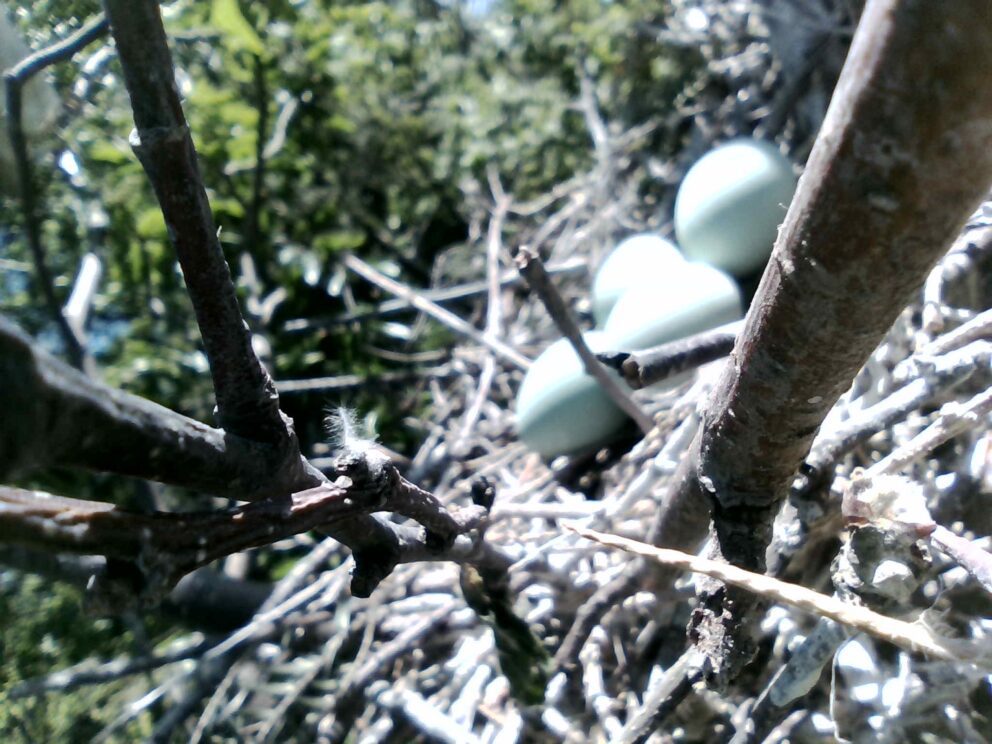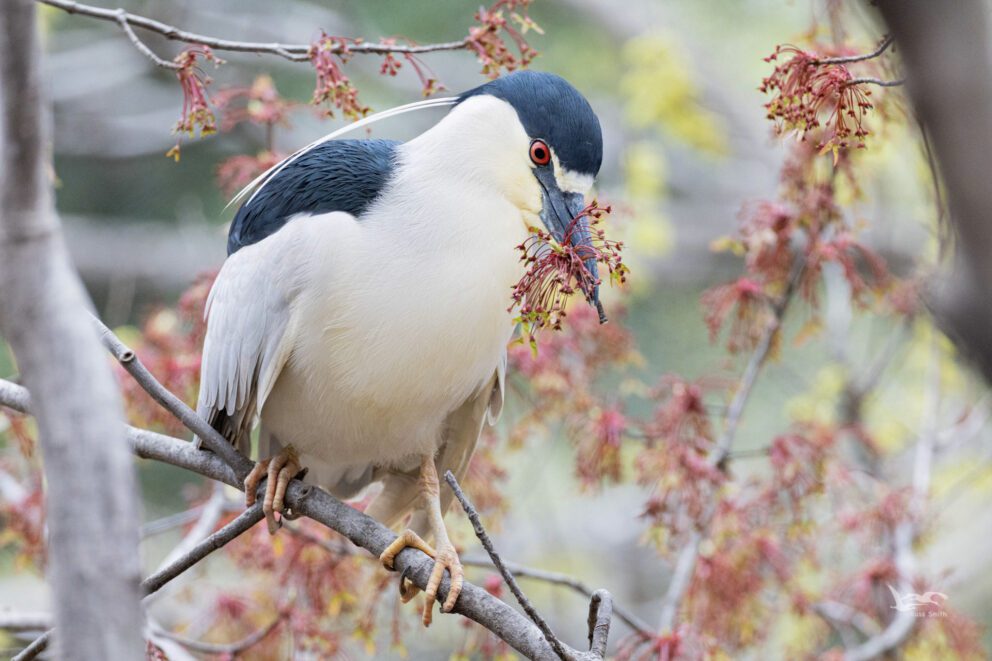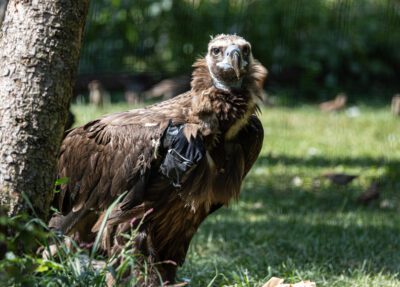Spring is here at last! And with warmer temperatures and all the wind and rain, millions of migrating birds also fly into the Chicago area. Among them are the state-endangered black-crowned night herons that make their nests right here at Lincoln Park Zoo. In late April, more than 760 members of this species were counted at Pritzker Family Children’s Zoo, making it a record-breaking year for the colony.
For more than a decade, the beautiful wild birds have arrived in Lincoln Park starting in late March, and they’ll stay here for much of the spring and summer. The Urban Wildlife Institute’s Wildlife Management Coordinator, Henry Adams, explains the expected timeline: “A week or two after the first birds come, that’s when we see courtship behavior and then nest selection. A lot of the birds reuse the nest structures from previous years,” they say. If you’re planning a trip to the zoo, you’ll want to note that the Children’s Zoo is partially closed this season to allow the herons to nest in peace.

Illustration by Wildlife Management Coordinator Henry Adams
The arrival of black-crowned night herons to Lincoln Park Zoo is part of a seasonal uptick in activity at the zoo. It means that more people are here, enjoying the flowers and animals at the zoo. The tulips are blooming, the waterfowl are out and about, and more animals are spending more time outside by their own choice. And along with all this, outdoor field research and educational activities are ramping up on grounds. Work focusing on the black-crowned night heron colony is definitely part of the zoo’s hectic spring schedule.
A Quick History of the Lincoln Park Zoo Colony
Back in 1977, black-crowned night herons were added to the Illinois Endangered Species list as a result of habit degradation and loss. Then in 2007, roughly 100 black-crowned night herons started nesting at the south edge of Lincoln Park Zoo. UWI started monitoring them in 2010.
While black-crowned night herons are generally solitary and territorial, they spend the months between April and August together and will choose nesting areas they have used before—at least, for a while. “Black-crowned night herons in general have a cyclical nature, an ephemeral nature, when it comes to their breeding colonies,” Adams explains. “They have a tendency to move to new sites every few decades.”
In 2012, the colony moved just a few acres north to the Children’s Zoo. Their current nesting spot is right above the red wolf habitat, which may be a smart choice for the herons. The mere presence of apex predators such as red wolves can deter smaller carnivorous mammals—like racoons and opossums—from sneaking into trees to prey on birds and their nests. “Our data shows that the night herons are actively selecting for nesting habitat in proximity to the red wolf habitat, suggesting that the wolves provide an added level of safety for the birds,” Adams says. “These kinds of relationships are frequently seen with various wading bird species, including night herons and American alligators in the southern U.S.”

Peak abundance for this colony generally takes place in early May—right now, basically. The group appears to be made up of a mix of migrating birds who fly south as far as Central America and birds who stick around the Chicago area and forage all winter at places like Douglass Park, Montrose Harbor, and River Park. Black-crowned night herons are partial migrators, meaning that some go south for the winter while others remain or travel just short distances during the cold season.
The zoo colony has steadily grown over the years, sometimes subsuming other groups of birds. The rookery at the zoo now regularly numbers roughly 700, with a high of more than 760 recorded this April and over 480 birds hatched in both 2023 and 2024.
Researching the Colony
With black-crowned night heron populations dwindling in parts of the world (including Illinois), plus their nomadic nature, it’s important to know more about how humans can help conserve these animals. The birds’ presence in Lincoln Park is important because it gives scientists at the zoo a rare opportunity to study black-crowned night heron behavior and learn more about their habits, health, and migration behavior.
To that end, Adams developed the zoo’s Urban Night Heron Conservation Program and helped established a multi-institutional group that works together to study the birds. Collaborators include the Chicago Black-crowned Night Heron Project, University of Illinois, Urbana-Champaign, Illinois Department of Natural Resources, Bird Conservation Network, and the Illinois Audobon Society. The zoo’s program has also developed and incorporated educational programming to allow Lincoln Park Zoo interns, college students, Chicagoland educators, and members of the public to learn about the birds and assist in their research and conservation.

During the past few years, this work has involved counting and monitoring the bird population here and around the city; tagging some birds with satellite transmitters; and taking blood, swabs, and feather samples. In 2024, scientists sampled 16 adult birds and 22 juveniles—one of the largest sample sets in existence for this species. “This is one of the benefits of having a colony so close to human habitation,” Adams says. “We can constantly monitor them, put in six to eight hours of survey time a day, and conduct multiple surveys a week. In June and July, when the hatched birds are around three to five weeks old, they are scampering around but not quite flighted yet. This is a sweet spot for sampling them.”
These activities make for long days, but the effort is worth it. These wild birds usually live in wetlands, tree islands, and exurban ecosystems that make them difficult to study. The colony at Lincoln Park Zoo, which nests adjacent to the fencing along the western side of the zoo, is habituated to human presence in a way that’s unique.
What We’ve Learned—On Migration, Avian Flu, and More
Research on the Lincoln Park Zoo colony over the last 15 or so years has focused on how the birds use the Chicagoland urban environment, to find ways to better manage and conserve their populations. Projects have also included determining preferred nesting height, foraging ranges, and resistance to highly pathogenic avian flu.
Banding and placing transmitters on black-crowned night herons has also led to some interesting information about their activities when they’re not on zoo grounds. One bird, known as A24, was banded in 2023. She has migrated all the way to south Florida for the past two winters, returning to Lincoln Park Zoo each year to raise chicks, and is expected to return again this season to her nest in the Children’s Zoo hemlocks. A39, another collared individual, has been migrating to Cuba, making that bird the zoo colony’s first known international traveler.
Other research has indicated that the black-crowned night heron colony at the zoo has not been significantly impacted by HPAI, which is good news considering how badly bird flu has affected animal populations this year.

Image courtesy of Russel Smith
“The research indicates that these birds are not being exposed to the pathogen and/or they are fairly resistant to infection, so we are encouraged that they are staying healthy,” Adams explains. “Other studies on their susceptibility to the virus show that the birds are not super-competent hosts. Even when inoculated with HPAI, only a small fraction of birds exposed developed an infection and symptoms. Fortunately, HPAI doesn’t seem to take hold very easily in black-crowned night herons.”
Future research based on the samples already taken will focus on the makeup of their diets, including how much of it comes from anthropogenic (or human-sourced) items and what levels of heavy metals the birds ingest. Continued health monitoring, conspecific attraction, and community engagement are also areas that zoo scientists and partners are working on. “This year we are focusing on wrapping up analyses from samples collected the last two years,” Adams says. “We will work with laboratories to do the actual analyses on feathers for heavy metals and collect further health data. This helps us determine if there are notable health differences between birds that may have something to do with the quality of the various grounds they forage at, and look at how the overall health of the colony might be changing.”
The Future of the Colony
It’s spectacular to watch the hundreds of black-crowned night herons in the zoo colony now, and zoo guests are very lucky to be able to see these birds so easily. But having so many black-crowned night herons together in one population is not the most desirable situation. “It’s a little like putting all your eggs in one basket, almost literally,” Adams explains. Should there be a catastrophic weather or disease event in the group, the number of black-crowned night herons in the state of Illinois would drop dramatically. Additionally, there’s limited space for the colony to grow, which means the population is limited by its location.
Thus, scientists would like to see the population disperse across multiple habitats rather than see the colony here expand. “The goal is to restore habitats to encourage these birds to return to breeding sites that they have used in previous years, such as areas in Calumet, Jackson Park, Almond Marsh, and Spring Lake. We want less dense, more spread out colonies, which is desirable from a population management standpoint. If they do that, they are more likely to establish distinct breeding populations and their overall genetic health and prospects in the wild would improve.”

How You Can Help the Birds
Zoo researchers and the rest of the Chicago night heron team are thrilled to have the opportunity to get to know these birds better and advance their conservation—not just in Illinois, but across their entire range, which includes parts of Europe, Asia, and North and South America. Adams and partners from the Chicago Black-crowned Night Heron Project, Illinois Audubon Society, and Windy City Bird Lab have been providing more and more opportunities for members of the public to connect with this local endangered species and engage in their conservation. Outreach programs have included lectures, outings to observe the herons, craft nights to paint conspecific attraction decoys, and more.
In fact, the night heron team is asking for the help of Chicagoans in tracking these birds! Since 2022, the team has banded over 70 night herons, and they want to know where these birds are spending their time. If you are a birding enthusiast of any experience level and would like to help the team monitor urban greenspaces for banded herons, you can sign up to be a part of this growing project! Email hadams@lpzoo.org to learn more.
Some of the areas to be monitored include North Pond, Jackson Park, Douglass Park, and more of the herons’ favorite haunts. The findings from this work will greatly assist in urban green space management and the conservation of the herons and many other urban wildlife species.








